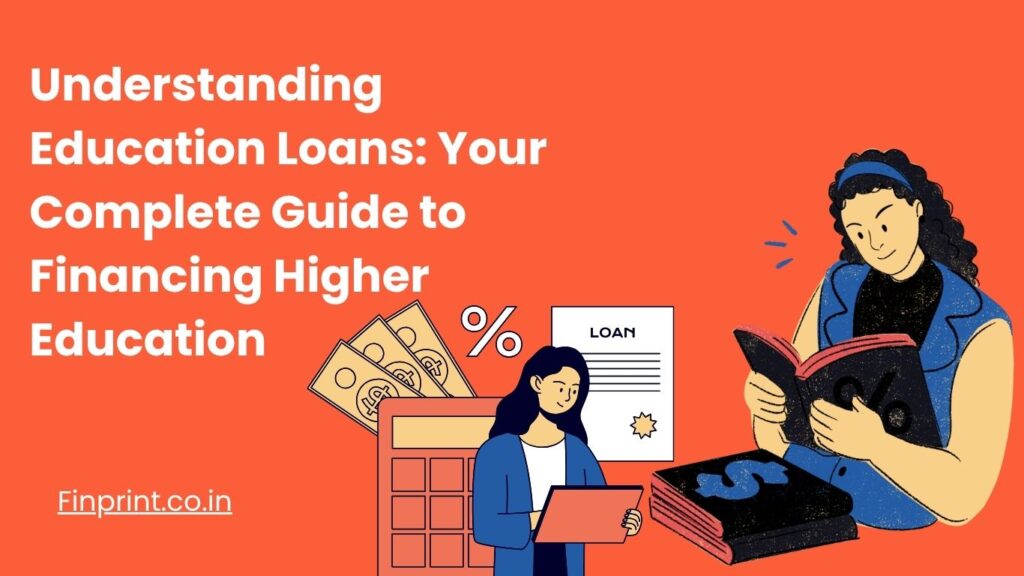Understanding Education Loans: Your Complete Guide to Financing Higher Education
The aspiration of higher education—be it a top engineering degree from India or a Masters from a foreign university—is typically followed by the query of finance. For Indian students and their families, an education loan is the turning point, bringing aspiration and reality  closer together. As a close collaborator in this process, the banking industry has a significant role to play. This handbook provides an exhaustive overview of how to explore the world of education loans so that you can make an informed decision for your future.
closer together. As a close collaborator in this process, the banking industry has a significant role to play. This handbook provides an exhaustive overview of how to explore the world of education loans so that you can make an informed decision for your future.
The Various Types of Education Loans Available in the Market
Education loans in India are categorized broadly into study location and course-wise. Knowing about them is the first step towards getting the right financial support:
- Domestic Education Loans: They are for students seeking higher studies in India. These tend to include tuition, hostel fees, library/examination charges, and the price of books. They tend to be more beneficial because they are tied to the Reserve Bank of India’s (RBI) repo rates.
- Overseas Education Loans: For those who want to pursue studies overseas, these loans generally finance a larger amount of money since the expenses are much higher (tuition, living, travel, visa charges, etc.). Because of the large amounts, they may involve collateral or a financially sound co-applicant.
- Govt. Schemes: schemes such as the Central Sector Interest Subsidy (CSIS) on the Model Education Loan Scheme of IBA and the PM-Vidyalaxmi Scheme exist, and these give interest subsidies for the period of moratorium (study period plus one year) to economically weaker section students. The Credit Guarantee Fund Scheme for Education Loan (CGFSEL) offers collateral-free loans to the value of up to ₹7.5 Lakh.
In the Indian scenario, the differential is typically between education loans for study at home and abroad and collateral-free loans (until \text{₹}7.5 Lakh) and secured loans (above \text{₹}7.5 Lakh).
Education Loan Eligibility Criteria for Applying
As a prerequisite to apply, ensure you satisfy the minimum requirements as specified by banks:
- Nationality: You have to be an Indian national.
- Admission: Verification of admission to an approved educational institution for a course authorized by the bank (a degree, diploma, or professional course).
- Academic Record: A fairly satisfactory academic record is usually demanded.
- Age: Although the age of the student is usually between 16 and 35, even the age of the co-applicant/guarantor is taken into consideration.
- Co-applicant/Co-signer Requirements: This is important. The bank will nearly always insist on a co-applicant, commonly the parent or guardian. For large loan sizes, a collateral security (such as property, Fixed Deposits, etc.) is usually required. Income and credit record (CIBIL score) of the co-applicant will play an important role in loan approval and interest rate fixation.
The Application Process: Steps to Obtain Your Education Loan
The education loan process is becoming more streamlined, usually going digital first:
- Compare and Check Eligibility: Begin by checking your eligibility across various banks and comparing their loan offers, interest rates, and processing charges.
- Documents Ready: Keep the student and co-applicant documents ready.
- Student: KYC (Aadhaar, PAN), academic mark sheets/certificates, and the institution’s admission letter.
- Co-applicant: KYC, proof of income (salary slips, Form 16/ITR), bank statements, and documents for collateral (if any).
- Submission of application: You can submit an application online via the website of the bank or the centralised government portal PM-Vidyalaxmi.
- Sanction and Disbursement: After the loan is approved by the bank (in-principle sanction may be provided even prior to an admissions letter), the sanction letter is issued. The loan proceeds are normally disbursed in phases, directly to the institution according to the fee schedule.
Public Sector Banks (PSBs)
Public sector banks are well-known for competitive interest rates and government subsidized education loan schemes.
- SBI Student Loan Scheme – For Indian students pursuing studies.
- SBI Global Ed-Vantage Scheme – For students pursuing higher education abroad with high loan limits and flexible repayment.
- Baroda Vidya – For school and domestic higher education.
- Baroda Scholarship – For international students.
- PNB Udaan – Specifically crafted for overseas studies, with easy disbursement and repayment of loans.
- Provide specially designed education loan schemes for payment of tuition, living, and other academic costs.
2. Private Sector Banks and NBFCs
Non-banking finance companies are popular for fast disbursement, customized loans, and minimal documentation, especially for overseas studies.
HDFC Bank & HDFC Credila Financial Services
- Offer prime institutions with high-value unsecured loans.
- Provide flexible payment schedules and easy co-applicant process.
- Both secured and unsecured education loans are offered.
- Includes pre-approved loans for certain universities.
- Offer comprehensive loan products that include tuition, living allowance, and travel cost for Indian and abroad studies.
Interest Rates and Repayment Options Described
Knowing the financial mechanics is the secret to long-term loan management
- Interest Rates: Indian education loan interest rates are usually floating rates, usually tied to an external benchmark such as the RBI Repo Rate or the Marginal Cost of Funds Based Lending Rate (MCLR) of the bank. They usually vary between 8% to 15% based on the amount of loan taken, security provided, and the ranking of the institution. Banks usually provide concessions for female students or students who get admission in top-class institutions.
- Repayment Plans: Majority of education loans have a moratorium period, i.e., the course duration plus a grace period (six months to one year). The repayment is usually made after that period.
- EMI Repayment: The most common repayment method is Equated Monthly Installments (EMIs). The longest tenure is normally up to 15 years.
- Moratorium Simple Interest: Most banks have the facility to pay simple interest for the student during the moratorium duration, thereby cutting down considerably the overall interest burden on the loan.
Tips to Manage Your Education Loan Effectively After Graduation
Graduation signals the end of your academic days but the start of your financial obligations.
- Leverage the Moratorium Period: If you are employed while enjoying the grace period, make use of it by paying off the accumulated simple interest or even prepaying early in order to cut down on the amount of principal.
- Budgeting: Incorporate your education loan EMI into your budget after graduation. Repay it as a non-negotiable fixed cost.
- Extra Payments: As and when possible, like through a performance bonus or salary increase, pay prepayments in lump sums. Indian banks do not typically levy prepayment charges on floating rate education loans.
- Tax Benefit: Don’t forget that you can claim a deduction of the entire interest on your education loan under Section 80E of the Income Tax Act.
Conclusion:
Seize Your Future with the Proper Education Loan Plan Today!
An education loan is an investment for your future, and not just a debt. If you take careful consideration in researching the various loans, fulfill the eligibility requirements, and keep a close eye on your repayments, you can be certain that financial limitations don’t undermine your academic plans. Join hands with a reliable bank today to get ready for a great, well-funded tomorrow.


